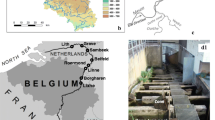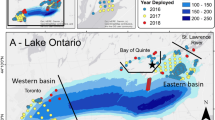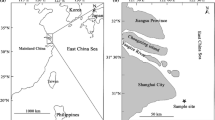Abstract
We investigated the environmental factors that affected temporal variability of eel recruitment and upstream migration in a freshwater coastal river along the southeastern US. Glass eels Anguilla rostrata were collected through ichthyoplankton sampling in the lower Roanoke River, North Carolina. Monthly samples were taken from fixed stations from May 2001 through June 2003. There was no evidence of consistent seasonal migration patterns for glass eels in Roanoke River. From May through December in 2001, glass eels were captured only during August. In 2002, glass eels arrived in February and remained in ichthyoplankton samples through October, with the exception of samples from September. Peak catch occurred in March at 4.02 ± 1.2 and declined through June to 0.18 ± 0.07 (#/1,000 m3). By August, the mean density increased to 0.96 ± 0.82 and to 3.59 ± 2.77 by October. In 2003 from January through June, glass eels were captured only during February and March. Glass eels were routinely collected when river discharge rates were <150 m3 s−1. River discharge rates >650 m−3 s−1 resulted in no glass eels in our samples. Upstream migration during 2002 was not correlated with water temperature or related to lunar phase. Glass eel freshwater upstream migration was initiated when water temperatures exceeded a threshold range of 10°C to 15°C; however, glass eels continued to migrate when water temperatures approached 30°C. The overall negative effect of river discharge suggests that changes in the water release schedules of upstream hydroelectric facilities during glass eel migration could strongly influence their recruitment success.




Similar content being viewed by others
References
Able KW, Fahay MP (1998) First year in the life of estuarine fishes in the middle Atlantic Bight. Rutgers University Press, New Brunswick, NJ, p 342
ASMFC (2000) Interstate fishery management plan for the American eel. ASMFC Fishery Management Report No. 36, Atlantic States Marine Fisheries Commission, Washington, DC
August S, Hicks B (2008) Water temperature and upstream migration of glass eels in New Zealand: implications of climate change. Environ Biol Fisches 81:195–205
Beaulaton L, Castelnaud G (2005) The efficiency of selective tidal stream transport in glass eel entering the Gironde (France). Bull Fr Peche Piscicult 378–379:5–21. doi:10.1051/kmae:2005001
Briand C, Fatin D, Fontenelle G, Feunteun E (2003) Estuarine and fluvial recruitment of the European glass eel, Anguilla anguilla, in an exploited Atlantic estuary. Fish Manag Ecol 10:377–384. doi:10.1111/j.1365-2400.2003.00354.x
Castonguay M, Hodson PV, Couillard CM, Eckersley MJ, Dutil JD, Verreault G (1994a) Why is recruitment of the American eel, Anguilla rostrata, declining in the St. Lawrence River and Gulf? Can J Fish Aquat Sci 51:479–488
Castonguay M, Hodson PV, Moriarty C, Drinkwater KF, Jessop BM (1994b) Is there a role of ocean environment in American and European eel decline? Fish Oceanogr 3:197–203. doi:10.1111/j.1365-2419.1994.tb00097.x
de Casamajor MN, Lecomte-Finiger R, Prouzet P (2006) Marine larval past of glass eel Anguilla anguilla migrating in the Adour estuary. Vie Et Milieu-Life Environ 56:1–8
Deelder CL (1958a) On the behaviour of elvers (Anguilla vulgaris Turt.) migrating from the sea into fresh water. ICES J Mar Sci 24:135. doi:10.1093/icesjms/24.1.135
Deelder CL (1958b) On the behaviour of elvers (Anguilla vulgaris Turt.) migrating from the sea into fresh water. Journal du Conseil Permanent International pour l’Exploration de la Mar 24:135
Gascuel D (1986) Flow-carried and active swimming migration of the glass eel (Anguilla anguilla) in the tidal area of a small estuary on the French Atlantic coast. Helgol Mar Res 40:321–326
Giese GL, Wilder HB, Parker GG (1985) Hydrology of major estuaries and sounds of North Carolina. Available from Dist Branch USGS 604 S. Pickett St., Alexandria, VA 22034. USGS Water-Supply Paper 2221, 1985. 108 p, 1 pl, 96 fig, 14 tab, 79 ref
Haeseker SL, Carmichael JT, Hightower JE (1996) Summer distribution and condition of striped bass within Albemarle Sound, North Carolina. Trans Am Fish Soc 125:690–704. doi:10.1577/1548-8659(1996)125<0690:SDACOS>2.3.CO;2
Haro A, Richkus W, Whalen K, Hoar A, Busch WD, Lary S et al (2000) Population decline of the American eel: implications for research and management. Fisheries 25:7–16. doi: 10.1577/1548-8446(2000)025<0007:PDOTAE>2.0.CO;2
Helfman GS, Bozeman EL, Brothers EB (1984) Size, age, and sex of American eels in a Georgia River. Trans Am Fish Soc 113:132–141. doi:10.1577/1548-8659(1984)113<132:SAASOA>2.0.CO;2
Jellyman DJ (1979) Upstream migration of glass-eels (Anguilla spp.) in the Waikato River. N Z J Mar Freshw Res 13:13–22
Jellyman DJ, Ryan CM (1983) Seasonal migration of elvers (Anguilla spp.) into Lake Pounui, New Zealand, 1974–1978. N Z J Mar Freshw Res 17:15
Jessop BM (1998) Geographic and seasonal variation in biological characteristics of American eel elvers in the Bay of Fundy area and on the Atlantic coast of Nova Scotia. Can J Zool 76:2172–2185. doi:10.1139/cjz-76-12-2172
Jessop BM (2003) Annual variability in the effects of water temperature, discharge, and tidal stage on the migration of American eel elvers from estuary to river. Am Fish Soc Symp 33:3–16
Kim WS, Yoon SJ, Moon HT, Lee TW (2002) Effects of water temperature changes on the endogenous and exogenous rhythms of oxygen consumption in glass eels Anguilla japonica. Mar Ecol Prog Ser 243:209–216. doi:10.3354/meps243209
Kleckner RC, McCleave JD (1985) Spatial and temporal distribution of American eel larvae in relation to North Atlantic Ocean current systems. Dana 4:67–92
Laffaille P, Caraguel JM, Legault A (2007) Temporal patterns in the upstream migration of European glass eels (Anguilla anguilla) at the Couesnon estuarine dam. Estuar Coast Shelf Sci 73:81–90. doi:10.1016/j.ecss.2006.12.011
McCleave JD, Kleckner RC (1982) Selective tidal stream transport on the estuarine migration of glass eels of the American eel (Anguilla rostrata). J Cons Cons Int Explor Mer 40:262–271
Mckinnon LJ, Gooley GJ (1998) Key environmental criteria associated with the invasion of Anguilla australis glass eels into estuaries of south-eastern Australia. Bull Fr Peche Piscicult 349:117–128
Meister AL, Flagg LN (1997) Recent developments in the American eel fisheries of eastern North America. Focus 22:25–26
NMFS (National Marine Fisheries Service) (2003). Annual commercial landing statistics. Available: http://www.st.nmfs.gov/st1/commercial/landings/annual_landings.htm. (July 2002).
Pietrafesa LJ, Janowitz GS (1991) The Albemarle-Pamlico coupling study. In: Final report to the environmental protection agency. North Carolina Department of Natural Resources and Community Development, Raleigh, NC, Project 90–13
Powles PM, Warlen SM (2002) Recruitment season, size, and age of young American eels (Anguilla rostrata) entering an estuary near Beaufort, North Carolina. Fish Bull (Wash, DC) 100:299–306
Rulifson RA, Manooch CS (1990) Recruitment of juvenile striped bass in the Roanoke River, North Carolina, as related to reservoir discharge. N Am J Fish Manage 10:397–407. doi:10.1577/1548-8675(1990)010<0397:ROJSBI>2.3.CO;2
Rulifson RA, Overton AS (2005) Ecology of larval fishes in the Lower Roanoke River, North Carolina. Final Report to Weyerhaeuser Paper Company. East Carolina University, Institute for Coastal and Marine Resources (ICMR). ICMR Contribution Series, No. ICMR-05-02:62
SAS Institute (2000) SAS version 8.01. SAS Institute, Cary, North Carolina
Schmidt J (1931) Eels and conger eels of the North Atlantic. Nature 128:602–604. doi:10.1038/128602a0
Schmidt N, Luther ME (2002) ENSO impacts on salinity in Tampa Bay, Florida. Estuaries and Coasts 25:976–984
Shiao JC, Tzeng WN, Collins A, Iizuka Y (2002) Role of marine larval duration and growth rate of glass eels in determining the distribution of Anguilla reinhardtii and A. australis on Australian eastern coasts. Mar Freshw Res 53:687–695. doi:10.1071/MF01037
Smith MW (1955) Control of eels in a lake by preventing the entrance of young. Can Fish Culturalist 17:13–17
Sola C, Tongiorgi P (1996) The effect of salinity on the chemotaxis of glass eels, Anguilla anguilla, to organic earthy and green odorants. Environ Biol Fishes, 47:213–218
Sorensen PW, Bianchini ML (1986) Environmental correlates of the freshwater migration of elvers of the American eel in a Rhode Island Brook. Trans Am Fish Soc 115:258–268. doi:10.1577/1548-8659(1986)115<258:ECOTFM>2.0.CO;2
Strubberg A (1913) The metamorphosis of elvers as influenced by outward conditions. Meddelelser fra Kommissionen for Havundersogelser. Serie 4:1–11
Sullivan MC, Able KW, Hare JA, Walsh HJ (2006) Anguilla rostrata glass eel ingress into two, US east coast estuaries: patterns, processes and implications for adult abundance. J Fish Biol 69:1081–1101. doi:10.1111/j.1095-8649.2006. 01182.x
Tesch FW (2003) The eel. Blackwell Science, Oxford, p 408
Tzeng WN (1985) Immigration timing and activity rhythms of the eel, Anguilla japonica, elvers in the estuary of northern Taiwan, with emphasis on environmental influences. Bull Jpn Soc Fish Oceanogr 47:11–28
Wang CH, Tzeng WN (1998) Interpretation of geographic variation in size of American eel Anguilla rostrata elvers on the Atlantic coast of North America using their life history and otolith ageing. Mar Ecol Prog Ser 168:35–43. doi:10.3354/meps168035
White EM, Knights B (1997) Environmental factors affecting migration of the European eel in the Rivers Severn and Avon, England. J Fish Biol 50:1104–1116. doi:10.1111/j.1095-8649.1997.tb01634.x
Williamson GR (1987) Vertical drifting position of glass eels, Anguilla rostrata, off Newfoundland. J Fish Biol 31:587–588. doi:10.1111/j.1095-8649.1987.tb05261.x
Acknowledgments
This study was funded by Weyerhaeuser Paper Company, Plymouth Mill, through a contract to East Carolina University. Our thanks to the Plymouth Mill for providing docking facilities and ensuring the safety and security of equipment and field personnel. A special thanks to D. Wynne, C. Gibson, D. McHenry, and S. Woock for logistical and financial support. The Institute for Coastal and Marine Resources provided laboratory and office space, additional equipment, and logistic support. Thanks to ECU’s Office of Diving and Water Safety for providing boats and boat maintenance. Many students contributed to completion of this project including C. Coggins, I. Coulson, F. Jarrett, J. Reuter and numerous others that assisted with field collections. We also thank several anonymous reviewers for providing useful comments in the preparation of this manuscript.
Author information
Authors and Affiliations
Corresponding author
Rights and permissions
About this article
Cite this article
Overton, A.S., Rulifson, R.A. Annual variability in upstream migration of glass eels in a southern USA coastal watershed. Environ Biol Fish 84, 29–37 (2009). https://doi.org/10.1007/s10641-008-9386-y
Received:
Accepted:
Published:
Issue Date:
DOI: https://doi.org/10.1007/s10641-008-9386-y




